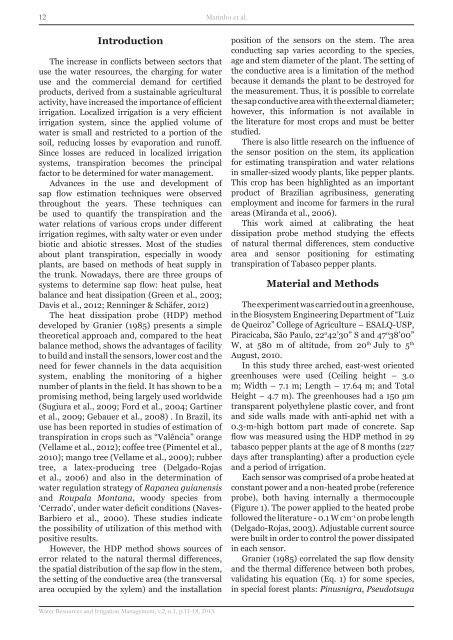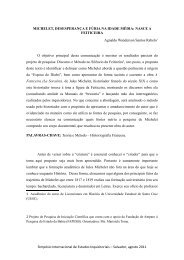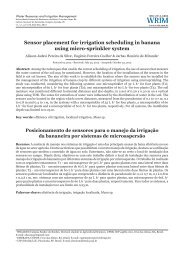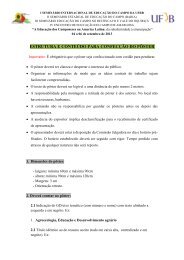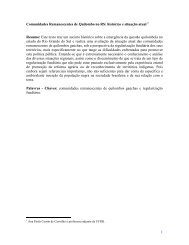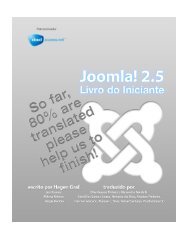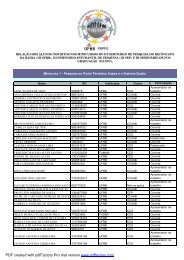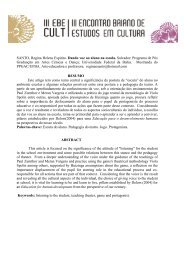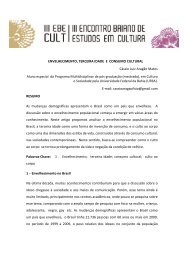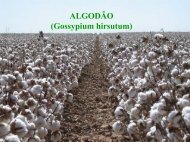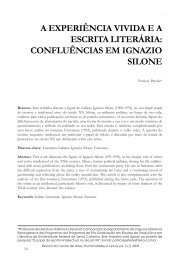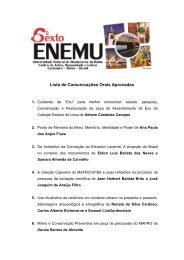Tabasco pepper transpiration by the heat dissipation probe ... - UFRB
Tabasco pepper transpiration by the heat dissipation probe ... - UFRB
Tabasco pepper transpiration by the heat dissipation probe ... - UFRB
You also want an ePaper? Increase the reach of your titles
YUMPU automatically turns print PDFs into web optimized ePapers that Google loves.
12Marinho et al.IntroductionThe increase in conflicts between sectors thatuse <strong>the</strong> water resources, <strong>the</strong> charging for wateruse and <strong>the</strong> commercial demand for certifiedproducts, derived from a sustainable agriculturalactivity, have increased <strong>the</strong> importance of efficientirrigation. Localized irrigation is a very efficientirrigation system, since <strong>the</strong> applied volume ofwater is small and restricted to a portion of <strong>the</strong>soil, reducing losses <strong>by</strong> evaporation and runoff.Since losses are reduced in localized irrigationsystems, <strong>transpiration</strong> becomes <strong>the</strong> principalfactor to be determined for water management.Advances in <strong>the</strong> use and development ofsap flow estimation techniques were observedthroughout <strong>the</strong> years. These techniques canbe used to quantify <strong>the</strong> <strong>transpiration</strong> and <strong>the</strong>water relations of various crops under differentirrigation regimes, with salty water or even underbiotic and abiotic stresses. Most of <strong>the</strong> studiesabout plant <strong>transpiration</strong>, especially in woodyplants, are based on methods of <strong>heat</strong> supply in<strong>the</strong> trunk. Nowadays, <strong>the</strong>re are three groups ofsystems to determine sap flow: <strong>heat</strong> pulse, <strong>heat</strong>balance and <strong>heat</strong> <strong>dissipation</strong> (Green et al., 2003;Davis et al., 2012; Renninger & Schäfer, 2012)The <strong>heat</strong> <strong>dissipation</strong> <strong>probe</strong> (HDP) methoddeveloped <strong>by</strong> Granier (1985) presents a simple<strong>the</strong>oretical approach and, compared to <strong>the</strong> <strong>heat</strong>balance method, shows <strong>the</strong> advantages of facilityto build and install <strong>the</strong> sensors, lower cost and <strong>the</strong>need for fewer channels in <strong>the</strong> data acquisitionsystem, enabling <strong>the</strong> monitoring of a highernumber of plants in <strong>the</strong> field. It has shown to be apromising method, being largely used worldwide(Sugiura et al., 2009; Ford et al., 2004; Gartineret al., 2009; Gebauer et al., 2008) . In Brazil, itsuse has been reported in studies of estimation of<strong>transpiration</strong> in crops such as “Valência” orange(Vellame et al., 2012); coffee tree (Pimentel et al.,2010); mango tree (Vellame et al., 2009); rubbertree, a latex-producing tree (Delgado-Rojaset al., 2006) and also in <strong>the</strong> determination ofwater regulation strategy of Rapanea guianensisand Roupala Montana, woody species from‘Cerrado’, under water deficit conditions (Naves-Barbiero et al., 2000). These studies indicate<strong>the</strong> possibility of utilization of this method withpositive results.However, <strong>the</strong> HDP method shows sources oferror related to <strong>the</strong> natural <strong>the</strong>rmal differences,<strong>the</strong> spatial distribution of <strong>the</strong> sap flow in <strong>the</strong> stem,<strong>the</strong> setting of <strong>the</strong> conductive area (<strong>the</strong> transversalarea occupied <strong>by</strong> <strong>the</strong> xylem) and <strong>the</strong> installationposition of <strong>the</strong> sensors on <strong>the</strong> stem. The areaconducting sap varies according to <strong>the</strong> species,age and stem diameter of <strong>the</strong> plant. The setting of<strong>the</strong> conductive area is a limitation of <strong>the</strong> methodbecause it demands <strong>the</strong> plant to be destroyed for<strong>the</strong> measurement. Thus, it is possible to correlate<strong>the</strong> sap conductive area with <strong>the</strong> external diameter;however, this information is not available in<strong>the</strong> literature for most crops and must be betterstudied.There is also little research on <strong>the</strong> influence of<strong>the</strong> sensor position on <strong>the</strong> stem, its applicationfor estimating <strong>transpiration</strong> and water relationsin smaller-sized woody plants, like <strong>pepper</strong> plants.This crop has been highlighted as an importantproduct of Brazilian agribusiness, generatingemployment and income for farmers in <strong>the</strong> ruralareas (Miranda et al., 2006).This work aimed at calibrating <strong>the</strong> <strong>heat</strong><strong>dissipation</strong> <strong>probe</strong> method studying <strong>the</strong> effectsof natural <strong>the</strong>rmal differences, stem conductivearea and sensor positioning for estimating<strong>transpiration</strong> of <strong>Tabasco</strong> <strong>pepper</strong> plants.Material and MethodsThe experiment was carried out in a greenhouse,in <strong>the</strong> Biosystem Engineering Department of “Luizde Queiroz” College of Agriculture – ESALQ-USP,Piracicaba, São Paulo, 22 0 42’30” S and 47 0 38’00”W, at 580 m of altitude, from 20 th July to 5 thAugust, 2010.In this study three arched, east-west orientedgreenhouses were used (Ceiling height – 3.0m; Width – 7.1 m; Length – 17.64 m; and TotalHeight – 4.7 m). The greenhouses had a 150 µmtransparent polyethylene plastic cover, and frontand side walls made with anti-aphid net with a0.3-m-high bottom part made of concrete. Sapflow was measured using <strong>the</strong> HDP method in 29tabasco <strong>pepper</strong> plants at <strong>the</strong> age of 8 months (227days after transplanting) after a production cycleand a period of irrigation.Each sensor was comprised of a <strong>probe</strong> <strong>heat</strong>ed atconstant power and a non-<strong>heat</strong>ed <strong>probe</strong> (reference<strong>probe</strong>), both having internally a <strong>the</strong>rmocouple(Figure 1). The power applied to <strong>the</strong> <strong>heat</strong>ed <strong>probe</strong>followed <strong>the</strong> literature - 0.1 W cm -1 on <strong>probe</strong> length(Delgado-Rojas, 2003). Adjustable current sourcewere built in order to control <strong>the</strong> power dissipatedin each sensor.Granier (1985) correlated <strong>the</strong> sap flow densityand <strong>the</strong> <strong>the</strong>rmal difference between both <strong>probe</strong>s,validating his equation (Eq. 1) for some species,in special forest plants: Pinusnigra, PseudotsugaWater Resources and Irrigation Management, v.2, n.1, p.11-18, 2013.


